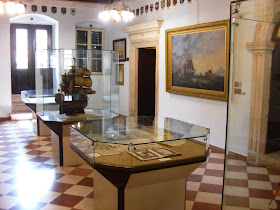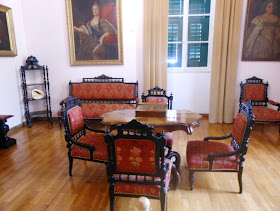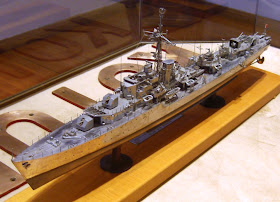During my recent cruise my wife and I had the opportunity to visit the Maritime Museum in Kotor, Montenegro.
The Museum is situated in a three-storey building near the centre of the city.
The entrance on the ground floor leads into a lobby. Entrance tickets (that include the cost of an audio guide) and postcards can be bought from the desk in the far left corner of the lobby.
We began by climbing the stairs to the top floor of the building. The central part of the floor was occupied by several large display cases, and in each corner was a door leading to a smaller room that was either furnished in a particular style or that housed a specific part of the Museum's collection.
The first floor followed a similar plan.
One room housed a collection of sailors' uniforms as well as a number of historical documents and images of famous seafarers from the region.
Another room was dedicated to the Yugoslav merchant marine, and in particular ships that were built and operated by Montenegrins.
Two of the other rooms housed some beautiful antique furniture, and showed how the region's links to the sea had brought it great wealth.
There was also a room dedicated to the ships and men of the Royal Yugoslav Navy and the Republic of Yugoslavia's Navy.
The rooms contained a variety of different ship models, a selection of which are shown below.
Sailing Ships
Nineteenth and Twentieth Century Merchant Ships
Twentieth Century Warships
The French-built Zagreb. She was a member of the three-ship Beograd-class, and was scuttled at Kotor in April 1941 to prevent her capture by the Italian Navy.
Her maximum speed was 38 knots, and she was armed with 4 × 120mm (4.7-inch) QF Guns, 4 × 40mm AA Guns, 2 × Machine Guns, and 6 × 533mm (21-inch) Torpedo Tubes. She could also carry up to 30 mines.
The British-built Kotor (ex-Royal Navy Kempenfelt) was sold to Yugoslavia in 1956 (along with her sister-ship, Wager, renamed Pula). She was renamed Kotor and served until being decommissioned and scrapped in 1971.
Her maximum speed was 36 knots, and she was armed with 4 × 120mm (4.7-inch) QF Guns, various AA Guns, and 8 × 533mm (21-inch) Torpedo Tubes.
The Museum is situated in a three-storey building near the centre of the city.
The entrance on the ground floor leads into a lobby. Entrance tickets (that include the cost of an audio guide) and postcards can be bought from the desk in the far left corner of the lobby.
We began by climbing the stairs to the top floor of the building. The central part of the floor was occupied by several large display cases, and in each corner was a door leading to a smaller room that was either furnished in a particular style or that housed a specific part of the Museum's collection.
The first floor followed a similar plan.
One room housed a collection of sailors' uniforms as well as a number of historical documents and images of famous seafarers from the region.
Another room was dedicated to the Yugoslav merchant marine, and in particular ships that were built and operated by Montenegrins.
Two of the other rooms housed some beautiful antique furniture, and showed how the region's links to the sea had brought it great wealth.
There was also a room dedicated to the ships and men of the Royal Yugoslav Navy and the Republic of Yugoslavia's Navy.
The rooms contained a variety of different ship models, a selection of which are shown below.
Sailing Ships
Nineteenth and Twentieth Century Merchant Ships
Twentieth Century Warships
The French-built Zagreb. She was a member of the three-ship Beograd-class, and was scuttled at Kotor in April 1941 to prevent her capture by the Italian Navy.
Her maximum speed was 38 knots, and she was armed with 4 × 120mm (4.7-inch) QF Guns, 4 × 40mm AA Guns, 2 × Machine Guns, and 6 × 533mm (21-inch) Torpedo Tubes. She could also carry up to 30 mines.
The British-built Kotor (ex-Royal Navy Kempenfelt) was sold to Yugoslavia in 1956 (along with her sister-ship, Wager, renamed Pula). She was renamed Kotor and served until being decommissioned and scrapped in 1971.
Her maximum speed was 36 knots, and she was armed with 4 × 120mm (4.7-inch) QF Guns, various AA Guns, and 8 × 533mm (21-inch) Torpedo Tubes.



























What a great museum! Savannah. Ga. has a similar museum. I can spend hours in there enjoying the models and film presentations.
ReplyDeleteI love all things that are Nautical! Thanks for posting Bob !!!
ReplyDeleteJeff
What a great find Bob.
ReplyDeleteI would never have thought that Montenegro would have enough maritime history to fill such a nice museum.
Jim
Steven Page,
ReplyDeleteIt is amazing how many good museums there are out there that people just don't know about.
If I ever make it to Savannah I will certainly try to visit the maritime museum if I have time.
All the best,
Bob
Chasseur (Jeff),
ReplyDeleteIt was my pleasure!
All the best,
Bob
Jim Duncan,
ReplyDeleteBecause of Montenegro's links with the former Yugoslavia, the museum covered the history of the eastern side of Adriatic as well as just Montenegro's maritime history.
All the best,
Bob